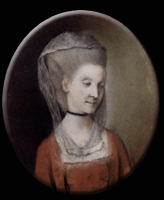Note: There are several people discussed in this piece who share names. To avoid confusion, whenever possible William Hewson will be referred to by his last name and the Hunter brothers will be called by their first names.
*****
When you google “Benjamin Franklin” and ‘“bones” most of what you’ll get is tabloid headlines inquiring as to whether or not Franklin was a serial killer. The answer is no. Rather, the bones in the basement of 36 Craven Street were the result of an anatomy school run by William Hewson in what was once the garden.
*****
Who’s Who
William Hewson
William Hewson was born on November 14, 1739, and was one of 11 children, very few of whom survived to adulthood. When he was 20 years old, he moved to London and began to study anatomy under William and John Hunter. When they thought he had learned a great deal, the Hunter brothers allowed Hewson to teach some of the newer students. Hewson worked with William Hunter for a time before the two had a disagreement. The issue largely came down to the fact that Hewson, “…decided to live in a house of his own rather than Hunter’s house/lecture rooms/museum.” Benjamin Franklin played a hand in mediating the dispute and the two were able to reach an amicable solution. Hewson opened his own anatomy school in September 1772 at 36 Craven Street.
In 1769, Hewson was awarded the Copley Medal but he was not admitted into the Royal Society until March 8, 1770. According to the Royal Society, “First awarded in 1731…it was initially awarded for the most important scientific discovery or for the greatest contribution made by experiment.”
On May 1, 1774, Hewson died tragically of septicaemia. According to George Gulliver, Hewson’s wife, Polly, whom he married in 1770, wrote of him, “A better son and husband, or a fonder father than Mr. Hewson never existed…. Mr. Hewson’s manners were gentle and engaging; his ambition was free from ostentation, his prudence was without meanness, and he was more covetous of fame than of fortune.”
William Hunter
William Hunter was born on May 23, 1718. He was the seventh of ten children and the older brother of John Hunter. He began studying at Glasgow University in 1731 with the intention of joining the church but did not graduate. Instead, he studied under Alexander Monro for a year, followed by studying midwifery under William Smellie. Because of his time under Smellie, Hunter, “began building a surgical and midwifery practice, investigating female reproductive anatomy using animals.” He started teaching anatomy lessons featuring human corpses in 1746 and continued doing so until he died.
One of his main areas of study was the gravid uterus. In 1750, “Hunter had his first opportunity to dissect a full-term gravid uterus…and was able to determine the relationship between the maternal and foetal blood system in the placenta. This work confirmed that maternal blood reached the placenta but did not pass to the foetus.” His experience and research lead him to be inducted into the Royal Society on April 30, 1767. By that same year, he became physician extraordinary to the Queen. Queen Charlotte was not his only high-status patient; according to the Oxford Dictionary of National Biography, “…possibly because of his growing midwifery practice among the aristocracy. Hunter certainly seems to have developed personal qualities which brought him patients such as the Pitts, Hertfords, Lady Ossory, the Fitzroys, the earl of Sandwich, Lord North, the Coutts, and the Hollands.”
William fully opened his own anatomy school on Great Windmill Street, and “…began lecturing in the new anatomy theatre in 1767, and lived on the site from 1768.” He taught there for many years until he died on March 30, 1783, possibly of renal failure. Much of his work became disputed as he did not publish much of it and, “Pupils’ notes of his lectures are the only record of some of his discoveries.”
John Hunter
John Hunter was born on February 13, 1728. He attempted to find work in Scotland but ultimately moved to London at age 20 to work with his older brother, William Hunter. John studied at a variety of schools but could not obtain his certification to practice so he took a break from working. He ended up becoming a staff surgeon in the English Army in 1760 and was able to gain a lot of field experience. He wrote a paper called A Treatise on Blood, Inflammation, and Gun-shot Wounds, published posthumously, that detailed a better way to treat gunshot wounds.
John enjoyed collecting medical oddities for his personal collection, which totaled over 10,000 items. He made many contributions to science but never published many of his findings. Despite this, he was awarded the Copley Medal in 1787. Before he died in 1793, he requested that “…upon his death two specimens be preserved: his Achilles tendon, which ruptured in 1767 and healed through secondary ossification, and his heart.” Neither of them were preserved. He was originally buried in the Church of St Martin in the Field but was reburied in Westminster Abbey on March 28, 1859.
***
Anatomy Schools
How an anatomy school worked
Many anatomy schools, including William Hunter’s operated through only the winter season as the bodies would decompose to quickly otherwise. According to Roy Porter, “…near the top of the [specialization] list was midwifery, as surgeon-apothocaries discovered that obstetrics paid, for the baby you brought into the world became your patient for life.” Many students went to schools in either London or Scotland but the schools in London were more flexible. These schools led to a number of advancements in the medical field as lecturers demonstrated the techniques they had developed through dissections and practicing on cadavers.
Comparative Anatomy
Comparative anatomy was a very common practice. As stated in an article from the Journal of Anatomy, “The animal dissections were noted to have saw cuts in very similar positions to those found in the human skeletons….” Hewson was known to complete experiments utilizing comparative anatomy. A turtle spine and mercury were found within the pit of bones at Craven Street and Hewson was known to have conducted an experiment in 1770 at the Royal Society using the flow of mercury through a turtle to show the lymphatic system.
The Hunterian Collection
John Hunter was known for collecting cadavers with medical abnormalities. Ruth Richardson writes of his collection containing, “monstrous births (animal and human) in bottles, the skeletons of physical freaks, a cast of the brain cavity of Dean Swift’s skull, death masks, murderers’ skeletons and relics, and all sorts and conditions of medical prodigies – feet, heads, internal organs – pickled or dyed to show their peculiarities to better effect.”
One such example of this was the body of Charles Byrne. He had a tumor that caused him to be abnormally tall, measuring 8 ft. 4 in. by the time of his death. He was part of a traveling exhibition using the title of “The Irish Giant.” When he died at age 22, he wanted to be buried at sea so anatomists would not be able to dissect him but, John Hunter was able to obtain his body for approximately £500. After he was dissected, his skeleton was placed on display. According to the Royal College of Surgeons, when the Hunterian museum reopens,“…Charles Byrne’s skeleton will not be displayed…but will still be available for bona fide medical research into the condition of pituitary acromegaly and gigantism.”
***
Obtaining Cadavers
In 1752, the Murder Act was passed, “which allowed for the corpses of executed murderers to be taken to the Company of Surgeons in London for studying and teaching.” Dissection was often viewed as an additional layer of punishment for those who were executed. Sometimes prisoners would sell their bodies ahead of time to do things like pay debts but, “Riots at the gallows often sought to deny surgeons dissection rights over the dead, regardless of whether currency had changed hands.”
There were not nearly enough cadavers to supply all of the anatomy schools in London so many surgeons resorted to obtaining bodies from graverobbers, also known as resurrectionists. As Ruth Richardson writes, “…exhumation was not technically a crime of theft; for although dead human bodies were in face bought and sold, in the eyes of the law a dead body did not constitture real property and therefore could neither be owned nor stolen.” Unless the grave robber was caught in possession of the effects of the deceased or had damaged the coffin in some way, they would not be punished by the law.
There were some, such as William Burke and William Hare, who took it upon themselves to “create” cadavers for medical schools. Hare ran a lodging house and after one of the lodgers passed away, they sold his body to Dr. Robert Knox for his dissections. After making a profit, they began to murder people by suffocating them. They continued to sell them to Dr. Knox. Their practice continued from November 1827 to October 31, 1828. When they were caught, Hare gave evidence against Burke then left for Ireland. Burke was hung and dissected. Knox’s knowledge of the murders could not be verified so he was not punished.
Most of the bodies taken from graves for dissection were those of the poor as their graves were often in mass and their coffins were cheap, making them easy targets. There were often groups of people who would work together to rob graves. They operated with the goal of making it look as though the grave had never been disturbed. They often would not take the bodies of a person who had clearly had an infectious disease. That said, according to Ruth Richardson, Astley Cooper was quoted as saying, “The law does not prevent our obtaining the body of an individual if we think proper; for there is no person, let his situation in life be what it may, whom if I were disposed to dissect, I could not obtain.”
The rules around the body trade changed after the Warburton Anatomy Act of 1832. Parliament writes, “…the Anatomy Act of 1832 gave surgeons and their students’ legal access to the bodies from workhouses, hospitals and prisons that were unclaimed 48 hours after death. It was also made possible for a person to donate a next of kin’s body for medical study.”
***
Conclusion
The bones found in the basement of 36 Craven Street show marks from surgical instruments. There is a femur bone that shows signs of having been amputated and a number of skulls with small circles drilled out, known as trepanning. Many other bones showed signs of having been amputated or cut away to be removed in a particular fashion.
When Hewson died, Benjamin Franklin wrote to Deborah of him, saying:
“Our Family here is in great Distress. Poor Mrs. Hewson has lost her Husband, and Mrs. Stevenson her Son-in-law. He died last Sunday Morning of a Fever which baffled the Skill of our best Physicians. He was an excellent young Man, ingenious, industrious, useful, and belov’d by all that knew him. She is left with two young Children, and a third soon expected. He was just established in a profitable growing Business, with the best Prospects of bringing up his young family advantageously.”




